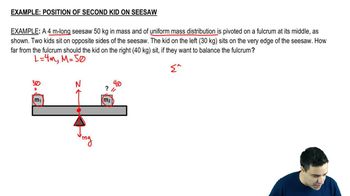Equilibrium with Multiple Objects definitions Flashcards
 Back
BackEquilibrium with Multiple Objects definitions
1/15
Terms in this set (15)
- Rotational EquilibriumA state where the sum of all torques acting on a system is zero, resulting in no rotational motion.
- TorqueA measure of the force causing an object to rotate, calculated as force times distance from the pivot point.
- FulcrumThe pivot point around which a lever or seesaw rotates.
- Uniform Mass DistributionA condition where mass is evenly distributed across an object, affecting its balance and center of gravity.
- Axis of RotationThe line around which an object rotates, where forces acting on it do not produce torque.
- Normal ForceThe force exerted by a surface perpendicular to an object resting on it, often counteracting gravity.
- SeesawA lever system with a fulcrum in the middle, used to demonstrate principles of balance and torque.
- MassA measure of the amount of matter in an object, influencing the gravitational force it exerts.
- DistanceThe length between two points, crucial in calculating torque as it affects leverage.
- GravityThe force that attracts a body toward the center of the earth, affecting weight and balance.
- BalanceA state where opposing forces or influences are equal, resulting in stability.
- PivotA fixed point supporting something that turns or balances, synonymous with fulcrum.
- LeverA rigid bar resting on a pivot, used to help move a heavy or firmly fixed load with one end when pressure is applied to the other.
- Center of GravityThe point in a body or system where the weight is evenly distributed or balanced.
- ForceAn influence that can change the motion of an object, crucial in calculating torque.


